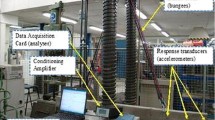Abstract
This paper proposes a strategy to avoid false alarms by distinguishing operation effects from damages effects in composite laminates. This strategy is based on active and sensing piezoelectric patches receiving Lamb waves that can be profoundly affected by operational factors such as load leading to false diagnostics. In order to overcome this drawback, this paper proposes an approach analyzing the use of prediction errors obtained by auto-regressive (AR) models. This index is computed using only the output signal received from sensors and combined with other traditional sensitive-damage indices. The fuzzy clustering technique is then applied for distinguishing the load effects from the effects of the damage. The method is evaluated using a carbon fiber-reinforced polymer coupons subject to tension–tension fatigue and with layers of piezoelectric sensors and actuators bonded on this surface. The results revealed that fuzzy clustering using a fuzzy c-means (FCM) algorithm could distinguish these effects using one-step-ahead AR errors combined with other standard indices extracted in time and frequency domains. This strategy may be easily implemented for signal processing, making possible its online application in a real-world structure.











Similar content being viewed by others
Notes
References
Bartelds G (1997) Aircraft structural health monitoring, prospects for smart solutions from a European viewpoint. Struct Health Monit Curr Status Perspect 9:293–300
Su Z, Ye L, Lu Y (2006) Guided Lamb waves for identification of damage in composite structures: a review. J Sound Vib 295(3):753–780
Farrar CR, Worden K (2007) An introduction to structural health monitoring. Philos Trans R Soc A Math Phys Eng Sci 365(1851):303–315
Kessler SS, Spearing SM, Soutis C (2002) Damage detection in composite materials using Lamb wave methods. Smart Mater Struct 11(2):269
da Silva S, Dias MD Jr, Lopes V Jr (2008) Structural health monitoring in smart structures through time series analysis. Struct Health Monit 7(3):231–244
Park G, Figueiredo E, Farinholt KM, Farrar CR (2010) Time series predictive models of piezoelectric active-sensing for SHM applications. In: Kundu T (ed) SPIE smart structures and materials nondestructive evaluation and health monitoring. International Society for Optics and Photonics, San Diego, CA, pp 765004–765004
da Silva S, Dias M Jr, Lopes V Jr (2007) Damage detection in a benchmark structure using AR-ARX models and statistical pattern recognition. J Braz Soc Mech Sci Eng 29(2):174–184
da Silva S, Gonsalez CG, Lopes V Jr (2011) Adaptive filter feature identification for structural health monitoring in an aeronautical panel. Struct Health Monit 10(5):481–489
Yan AM, Kerschen G, De Boe P, Golinval JC (2005) Structural damage diagnosis under varying environmental conditions-part I: a linear analysis. Mech Syst Signal Process 19(4):847–864
Lim HJ, Kim MK, Sohn H, Park CY (2011) Impedance based damage detection under varying temperature and loading conditions. NDT Int 44(8):740–750
Figueiredo E, Park G, Farrar CR, Worden K, Figueiras J (2011) Machine learning algorithms for damage detection under operational and environmental variability. Struct Health Monit 10(6):559–572
da Silva S, Dias M Jr, Lopes V Jr, Brennan MJ (2008) Structural damage detection by fuzzy clustering. Mech Syst Signal Process 22(7):1636–1649
Lopes V Jr, Gonsalez C, da Silva S, Roy S, Kode K, Sunor F, Chang FK (2011) Characterization of the temperature, load and damage effects using piezoelectric transducer patchers based on fuzzy clustering. In: 8th international workshop on structural health monitoring 2011, Stanford, California, USA, pp 1196–1205
da Silva S (2018) Data-driven model identification of guided wave propagation in composite structures. J Braz Soc Mech Sci Eng 40:543
Cano WFR (2015) Application of time series analysis for damage detection and prognosis in smart structures. Master dissertation in Mechanical Engineering, UNESP, Ilha Solteira
Larrosa C, Lonkar K, Chang FK (2014) In situ damage classification for composite laminates using Gaussian discriminant analysis. Struct Health Monit 13(2):190–204
Corbetta M, Sbarufatti C, Giglio M, Saxena A, Goebel K (2018) A Bayesian framework for fatigue life prediction of composite laminates under co-existing matrix cracks and delamination. Compos Struct 187:58–70
Ljung L (1998) System identification: theory for the user, 2nd edn. Prentice-Hall, London, p 1998
Kopsaftopoulos F, Fassois S (2010) Vibration based health monitoring for a lightweight truss structure: experimental assessment of several statistical time series methods. Mech Syst Signal Process 24:1977–1997
Na WS, Baek J (2018) A review of the piezoelectric electromechanical impedance based structural health monitoring technique for engineering structures. Sensors 18:1307
Bezdek JC (1981) Pattern recognition with fuzzy objective function algorithms. Kluwer Academic Publishers, New York
Acknowledgements
The authors would like to thank the financial support provided by National Council of Technological and Scientific Development (CNPq/Brasil) Grant No. 307520/2016-1, and São Paulo Research Foundation (FAPESP/Brasil) Grant No. 2017/15512-8. This study was also financed in part by the Coordination for the Improvement of Higher Education Personnel (CAPES/Brasil)-Finance Code 001. The authors also like to thank Stanford Structures and Composites Laboratory (SACL) and the Prognostic Center of Excellence (PCoE) of NASA Armes Research Center for the data sets.
Author information
Authors and Affiliations
Corresponding author
Ethics declarations
Conflict of interest
The authors declare that there is no conflict of interests regarding the publication of this article.
Additional information
Technical Editor: Pedro Manuel Calas Lopes Pacheco, D.Sc.
Publisher's Note
Springer Nature remains neutral with regard to jurisdictional claims in published maps and institutional affiliations.
Rights and permissions
About this article
Cite this article
Cano, W.F.R., da Silva, S. Fuzzy clustering and AR models for damage detection in CFRP coupons considering loading effect. J Braz. Soc. Mech. Sci. Eng. 42, 241 (2020). https://doi.org/10.1007/s40430-020-02304-7
Received:
Accepted:
Published:
DOI: https://doi.org/10.1007/s40430-020-02304-7




